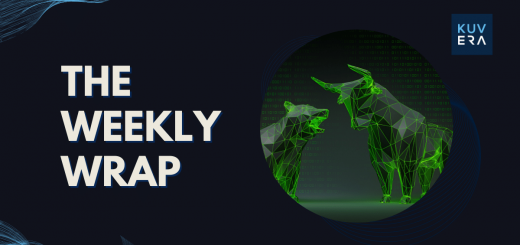In this edition, we talk about India’s latest shot at a moon-landing and why Prime Minister Narendra Modi’s visit to France is significant. We also talk about inflation, the floods in North India, and the quarterly results of India’s top IT companies.
Welcome to Kuvera’s weekly digest on the most critical developments related to business, finance, and the markets.
tl;dr Hear the article in brief instead?

India seems to be flying high, and quite literally at that.
The stock markets are at record highs and two of India’s biggest carriers—IndiGo and Air India—and their newbie rival Akasa have, among them, ordered more than 1,100 new planes as more and more Indians take to the skies.
And now, India is shooting for the moon. On Friday, India’s third lunar mission—Chandrayaan 3—successfully lifted off from Sriharikota in Andhra Pradesh, carrying the hopes of an entire nation. A successful mission will make India the fourth nation to land on the moon.
This mission became all the more crucial as India’s second attempt to land on the moon had failed at the last minute in July 2019, owing to a technical failure. The Indian Space Research Organisation (ISRO) will be keeping its fingers crossed.
To be sure though, a successful lift-off is just the beginning of an arduous journey.
The moon lander Vikram will be perched on a GSLV Mark 3 heavy lift launch vehicle. Renamed Launch Vehicle Mark 3 (LM-3), the GSLV stands 43.5 metres tall. The journey will take over 40 days—the spacecraft is likely to touch down on the moon on August 23.
More crucially though, India’s mooncraft will land in the South Pole of the moon, where water molecules have been found. The finding, made during India’s first moon mission in 2008, had startled the world.
The moon is not the only frontier India is scouting for. Prime Minister Narendra Modi was in France this week as the guest of honour at the country’s Bastille Day parade in Paris.
Modi was in Paris for much more than simply to revel in some pomp and show. He was there to negotiate and ink new multi-billion-dollar defence and business deals and to get Indian students in the European country easier work visas.
Not only is India buying 26 new Rafale jets for its air force and three new Scorpene submarines for the navy, the country is also looking for a collaboration with a foreign partner to develop its own stealth fighter jet dubbed the Advanced Medium Combat Aircraft (AMCA). Now, that will be one mean machine, but it is still a few years away.
What is already in vogue, however, is India’s own payments system, the Unified Payments Interface (UPI). Indian tourists visiting France will now be able to use UPI to make payments in rupees and do away with cumbersome forex cards.
So, the next time you are holidaying in the beautiful French Riviera, you won’t need to load yourself up with euros. Just take out your mobile phone and scan that QR code!
Slowing momentum
Coming back to earth, three of India’s four largest software services companies reported their first-quarter earnings this week. And, to put it mildly, the results were a mixed bag.
Tata Consultancy Services, the industry leader, reported a 17% year-on-year jump in consolidated net profit to Rs 11,074 crore, beating analysts’ estimates. Revenue from operations climbed 12.6% to Rs 59,381 crore.
HCL Technologies, the No.3 software services exporter, reported Q1 profit grew 7.7% to Rs 3,534 crore, missing analysts’ estimate. Revenue from operations increased 12.1% to Rs 26,296 crore, also missing estimates.
Wipro, the No.4 in the pecking order, said Q1 net profit rose nearly 12% from a year ago to Rs 2,870 crore and revenue from operations increased 6% to Rs 22,831 crore.
The results come at a time when India’s IT industry is staring at a recession in major markets like the US and Europe, after a pandemic-driven digital services boom.
TCS warned about near-term weakness in demand from clients amid global economic woes. HCL Tech also talked about a reduction in discretionary spending by clients and deferred annual pay hikes by a quarter. Wipro, too, flagged an uncertain demand environment and said it was too early to provide a forecast for the second half of the year.
Infosys, India’s second-biggest IT services provider, will report results next week.
Game over?
While the IT sector is battling a slowdown, another sunrise industry is staring at a bigger problem. The government this week decided to tighten its noose around the online gaming industry, which employs over 10,000 techies and which Forbes estimates caters to about 400 million online gamers in India including about 90-100 million regular gamers.

The Goods and Services Tax (GST) Council decided to impose a 28% tax on online gaming, horse racing and casinos. The gaming industry is predictably up in arms. Industry executives and observers say the move can cause huge losses to the sector, which has attracted millions of dollars in foreign investment.
The tax will be imposed at full value, regardless of the games based on skill or chance. Put simply, a gamer will have to pay Rs 28 for every Rs 100 spent in an online game. Moreover, gamers are subject to paying a 30% TDS if they win more than Rs 10,000 in a game. So, if you are a serious gamer, this could be a double whammy of sorts for you.
The GST on online gaming comes after the government dealt a body blow to India’s nascent crypto industry by imposing mandatory tax at source and then a 30% capital gains tax on profits.
Will the online gaming industry go the same way and will gamers now move to platforms outside India, bypassing the system using virtual private networks? If industry experts are to be believed, that is entirely possible and very likely.
Searching for tomatoes
Playing a game online isn’t the only activity that’s getting expensive. More mundane daily activities are getting expensive, too. Like cooking food, with tomato prices reaching for the moon!

India’s retail inflation hardened in June to a three-month high of 4.81% from 4.31% in May, driven by a spike in food price inflation to 4.5% from less than 3% in the previous month, owing to rising costs faced by households for items like cereals, pulses, milk and tomatoes. In fact, tomato prices shot up above Rs 300 per kg this week.
While the pace of consumer price rise in June broke a four-month streak of moderation from the 6.5% uptick recorded this January, urban consumers faced nearly 5% inflation in June with food price inflation nearly doubling from May’s 2.4% level to 4.3% last month.
June marked the fourth month in a row that retail inflation has stayed below the Reserve Bank of India’s upper tolerance threshold of 6% for consumer price rise. The upturn in vegetable prices and flooding in several parts of the country could exacerbate food price pressures on headline inflation.
In fact, the northern states of Himachal Pradesh, Uttarakhand, Punjab, Haryana and Delhi, besides Chandigarh, have been badly affected by the flooding that has submerged much of the region over the past fortnight. This, as record monsoon rains have killed more than 100 people over the past two weeks. Schools and colleges were closed after rains led to massive waterlogging, road caves-in, collapsed homes and gridlocked traffic in large parts of northern India.
We certainly hope the situation comes back to normal at the earliest.
Market Wrap
The two benchmark indices, it seems, are unstoppable. Over the last six months, the 30-share Sensex has climbed almost 9.3% while the 50-script Nifty has returned 8.7%. This week too, both the indices made their investors richer, ending up about 0.7% higher as both foreign institutional investors and domestic investors continue to pour money into the market.
In fact, both the benchmark indices climbed to new highs on Thursday, with the Sensex going past the 66,000 mark while the Nifty inched above 19,500, although both pared their gains in the second half of the day’s trading session.
The top Nifty stocks that helped the index gain new highs this week included Hindalco, Reliance Industries, Tata Motors, Infosys and Sun Pharma. The other counters that gained were Eicher Motors, Tata Steel, ONGC, TCS and Bharti Airtel.
Companies that left their investors poorer this week included the likes of Power Grid Corp, NTPC, UPL and Bajaj Finance. Other counters that ended in the red were HCL Tech, Hindustan Unilever, Bharat Petroleum and Adani Ports.
Other headlines
- Govt orders inspection of Byju’s accounts as edtech firm continues to struggle
- Govt considers banning most rice exports as local prices surge
- Index of Industrial Production grows 5.2% in May
- Go First’s insolvency resolution professional seeks expression of interest for possible sale
- Tatas set to acquire Wistron Corp factory, to become first Indian iPhone maker
- Foxconn in talks with Taiwan’s TSMC and Japan’s TMH Group to set up fab units in India
- CarTrade acquires OLX’s used-car business in India for Rs 537 crore
- Jio Financial Services to enter FTSE indices from July 20
- Godrej Properties to develop luxury homes in Gurugram with Rs 3,100 crore revenue potential
- Adani Enterprises issues first rupee bond since Hindenburg report
- Samco MF collects Rs 409 crore via Active Momentum Fund NFO, caps fresh investments
- ESAF Small Finance Bank refiles IPO draft prospectus, reduces issue size to Rs 629 crore
- Utkarsh Small Finance Bank IPO subscribed over 100 times
- Senco Gold lists at 36% premium
That’s all for this week. Until next week, happy investing!
Interested in how we think about the markets? Read more: Zen And The Art Of Investing
Watch here: Investing in Flexi cap funds
Start investing through a platform that brings goal planning and investing to your fingertips. Visit kuvera.in to discover Direct Plans and Fixed Deposits and start investing today.







